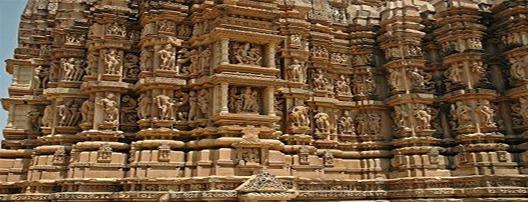

Khajuraho is situated in the state of Madhya Pradesh, the heart of Central India. Khajuraho is a fascinating village with a quaint rural ambience and a rich cultural heritage. Khajuraho or 'Khajur-vahika' (bearer of date palms), also known as 'Khajjurpura' in ancient times, evidently derives its name from the golden date palms (khajur) that adorned its city gates. Khajuraho was the capital of the Chandela dynasty. The Chandela Kings claimed descent from the moon. Khajuraho is famous all over the world due to its temples. The temples of Khajuraho are among the finest examples of temple craftsmanship in the whole of India. It is the most frequently visited place in India after Agra.
A UNESCO world heritage site in central India, Khajuraho is a famous tourist and archaeological site known for its sculptured temples dedicated to Shiva, Vishnu, and Jain patriarchs. Khajuraho was one of the capitals of the Chandela kings, who from the 9th to the 11th century CE developed a large realm, which at its height included almost all of what is now Madhya Pradesh state. Khajuraho extended over 21 sq. km and contained about 85 temples built by multiple rulers from about 950 to 1050. In the late 11th century the Chandela, in a period of chaos and decline, moved to hill forts elsewhere. Khajuraho continued its religious importance until the 14th century (Ibn Batuta was impressed by it) but was afterwards largely forgotten; its remoteness probably saved it from the desecration that Muslim conquerors generally inflicted on Hindu monuments. In 1838 a British army captain, TS Burt, employed by the Asiatic Society in Calcutta, came upon information that led him to the rediscovery of the complex of temples in the jungle in Khajuraho.
Of the 85 original temples-most constructed of hard river sandstone-about 20 are still reasonably well preserved. Both internally and externally the temples are richly carved with excellent sculptures that are frequently sensual and, at times, sexually explicit. The temples are divided into three complexes-the western is the largest and best known, containing the magnificent Shaivite temple Kandariya Mahadev, a 31m high agglomeration of porches and turrets culminating in a spire. Modern Khajuraho is a small village, serving the tourist trade with hotels and an airport. Khajuraho's name derives from the prevalence of khajur, or date palms, in the area.
Copyright © 2015 - All Rights Reserved - starholidayskerala.com
developed by Nucleus